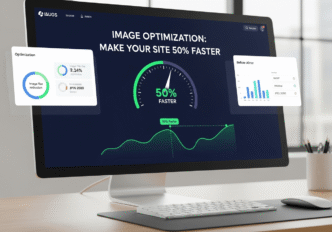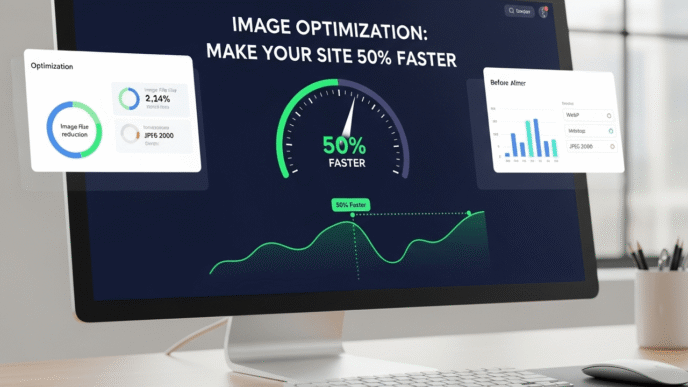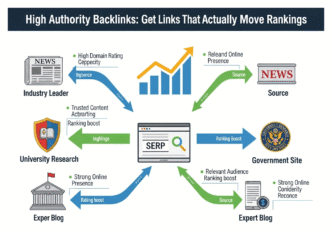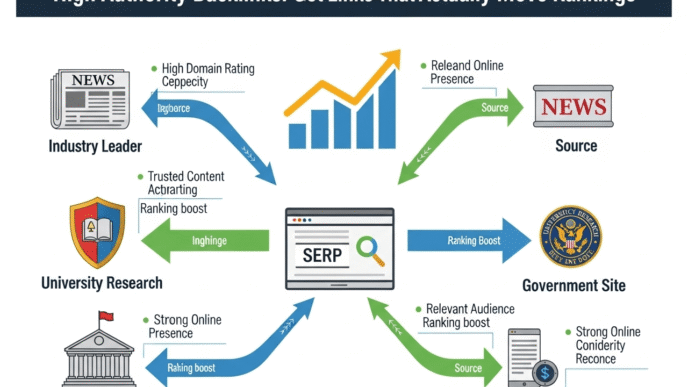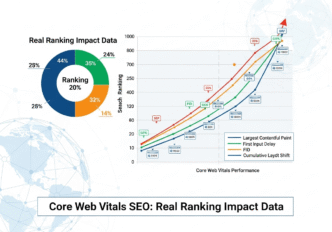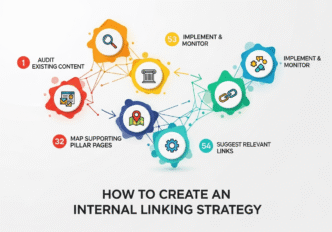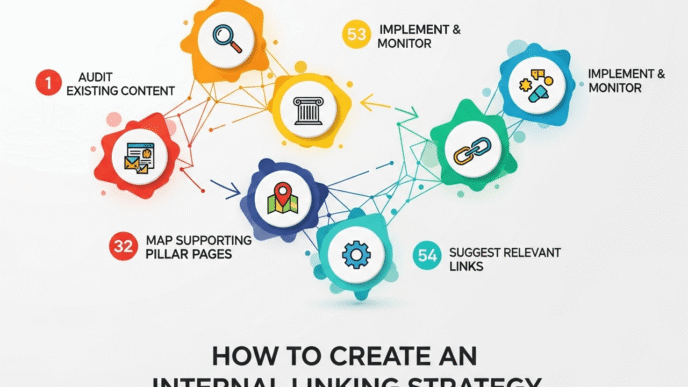You’ve written killer content, researched perfect keywords, and optimized every meta tag. But something’s still not clicking with Google. Your pages aren’t ranking where they should, and you can’t figure out why.
Here’s the plot twist: your content might be structurally broken in a way that’s invisible to human eyes but glaringly obvious to search engines. Poor header tag SEO hierarchy is the silent killer of otherwise excellent content, confusing both Google’s crawlers and your readers.
Table of Contents
Toggle
What Exactly Is Header Tag SEO Hierarchy?
Think of header tag SEO hierarchy as the skeleton of your webpage. Just like a building needs a solid framework, your content needs a logical structure that both humans and search engines can follow.
Header tags (H1, H2, H3, H4, H5, H6) are HTML elements that create a content hierarchy structure on your page. They’re like the outline you made in school – they show the relationship between different sections and help organize information logically.
But here’s what most people miss: Google doesn’t just read your content linearly. It scans your header tag structure to understand the topical flow and importance of each section.
Pro Tip: “Think of header tags as a table of contents for both users and search engines. A well-structured hierarchy tells Google exactly what your content is about and how it’s organized.” – Technical SEO Specialist
Why Does Header Tag Structure Matter for SEO?
Your header tag hierarchy is like GPS directions for Google’s crawlers. Without proper structure, search engines get lost trying to understand your content’s main topics and subtopics.
Here’s what happens when you nail your header structure optimization:
- Google understands your content’s topical focus
- Users can scan and navigate your content easily
- Featured snippet opportunities increase dramatically
- Semantic SEO signals become stronger
The relationship between header tags and SEO rankings is indirect but powerful. While headers aren’t a direct ranking factor, they influence user experience metrics that Google absolutely cares about.
How Should You Structure Header Tags Properly?
The proper header tag hierarchy follows a logical, nested structure that mirrors how we naturally organize information. Think of it as a family tree where each level has a clear relationship to the others.
The Header Tag Family Tree
| Header Level | Purpose | SEO Weight | Usage Guidelines |
|---|---|---|---|
| H1 | Main page title | Highest | One per page only |
| H2 | Major sections | High | Primary subtopics |
| H3 | Subsections under H2 | Medium | Supporting details |
| H4-H6 | Minor divisions | Lower | Specific points |
The Golden Rules of Header Hierarchy
Your header tag best practices should follow these non-negotiable rules:
- One H1 per page (your main title)
- H2s divide major topics (think book chapters)
- H3s break down H2 sections (like chapter subsections)
- Never skip levels (don’t jump from H2 to H4)
- Include keywords naturally in your header structure
Pro Tip: “Your header hierarchy should tell a complete story even if someone only reads the headers. If the flow doesn’t make sense with headers alone, restructure your content.” – Content Strategy Expert
Critical Header Tag Pitfalls to Avoid in 2025
Even experienced SEO professionals make these header tag hierarchy mistakes. Here are the deadly sins that’ll confuse both Google and your users:
The Multiple H1 Disaster
Bad Example: Having three H1 tags like “Welcome,” “About Us,” and “Our Services” on your homepage.
Why it’s wrong: Multiple H1s confuse search engines about your page’s primary focus. A weak negative correlation (−0.1172) was observed between rank and the presence of a single H1 tag, suggesting that having just one H1 tag is more common among higher-ranking pages.
Good Example: One H1 like “Professional SEO Services That Drive Real Results” with everything else as H2 or lower.
The Level-Skipping Problem
Bad Structure:
H1: Ultimate Guide to SEO
H4: Keyword Research Tips
H2: On-Page Optimization
Good Structure:
H1: Ultimate Guide to SEO
H2: Keyword Research Fundamentals
H3: Finding the Right Keywords
H2: On-Page Optimization Strategies
H3: Header Tag Best Practices
The Keyword Stuffing Header
Bad Example: “Best SEO Header Tags SEO Optimization Header SEO Tags Best“
Good Example: “How to Optimize Header Tags for Better SEO Performance”
The difference? Natural language that includes keywords without sounding robotic.
The Accessibility Ignorance Mistake
Failing to consider screen readers and visually impaired users. Headers should create a logical flow that assistive technology can interpret.
The Mobile Responsiveness Oversight
Creating headers that work on desktop but break the user experience on mobile devices, where the majority of searches now occur.
The AI Optimization Neglect
Not considering how AI search engines like ChatGPT and Perplexity interpret your header structure for content citations.
Pro Tip: “Your header hierarchy should tell a complete story even if someone only reads the headers. If the flow doesn’t make sense with headers alone, restructure your content. AI systems particularly rely on this logical flow.” – Technical SEO Specialist
Essential External Resources for Header Tag Excellence
Mastering header tag SEO hierarchy requires authoritative guidance and reliable tools:
Google’s Official Developer Guidelines
Google’s HTML Heading Best Practices provides the official stance on header tag implementation. Google’s Gary Illyes clarified in July 2024 that hierarchical ordering of heading tags is not important for SEO rankings, but they remain crucial for user experience and accessibility.
W3C Web Accessibility Guidelines
W3C’s Heading Structure Guidelines offers comprehensive guidance on creating accessible header hierarchies. This resource is essential for understanding how screen readers interpret header structures.
Conductor’s SEO Academy
Conductor’s Complete Header Tags Guide provides practical, data-driven insights into header tag optimization. Their research shows how header tags enhance user experience and provide semantic cues to search engines.
Screaming Frog SEO Tools
Screaming Frog’s Header Analysis Features enable comprehensive auditing of header structures across large websites, helping identify missing H1s, multiple H1s, and hierarchy issues at scale.
2025 Statistics: The Data Behind Header Tag Performance
Recent research reveals the true impact of proper header tag structure:
H1 Tag Correlation Data
A 2025 case study analyzing the top 40 Google search results found a weak negative correlation (−0.1172) between rank and the presence of a single H1 tag, suggesting that having just one H1 tag is more common among higher-ranking pages.
Multiple H1 Impact
A moderate positive correlation (0.3078) was found between rank and pages with more than one H1 tag, but this doesn’t necessarily mean multiple H1s benefit SEO—it simply indicates a trend in modern web frameworks.
Keyword Matching Performance
A weak negative correlation (−0.2670) was identified between rank and the exact keyword phrase’s presence in the H1 tag, showing that exact keyword matches aren’t as critical as previously thought.
Featured Snippet Opportunities
Well-structured headers significantly increase featured snippet opportunities, with Google often pulling snippets from content that follows clear H2 or H3 question formats.
Data Visualization: Header Tag Performance Metrics
| Header Practice | SEO Impact | User Experience | AI Optimization |
|---|---|---|---|
| Single H1 per page | High correlation with top rankings | Excellent clarity | Optimal for AI parsing |
| Logical hierarchy (H1→H2→H3) | Moderate positive impact | Enhanced scanability | Better content understanding |
| Keyword-rich headers | Low direct correlation | Good when natural | Helps with semantic analysis |
| Question-based H2s | High featured snippet potential | Excellent UX | Perfect for voice search |
| Mobile-optimized length | Indirect ranking benefit | Critical for mobile users | Essential for AI citations |
Trending AI/SEO Topics Impacting Header Tags
The SEO landscape is rapidly evolving with AI integration. Here’s what’s transforming header tag optimization:
AI Search Engine Optimization
With ChatGPT processing over 37.5 million prompts daily and AI overviews appearing in 60% of Google searches, your header tag structure must work for both traditional and AI-powered search systems.
ChatGPT SEO and Header Optimization
AI tools like ChatGPT are revolutionizing how we approach header tag research and optimization. 47% of marketers are already implementing AI SEO tools to improve search efficiency, including header structure analysis.
Popular AI prompts for header optimization:
- “Analyze my current header structure and suggest improvements for better SEO”
- “Create a logical header hierarchy for content about [topic]”
- “Generate question-based H2 headers that target featured snippets”
Voice Search and Conversational Headers
With voice search optimization becoming critical, headers must incorporate natural, conversational language that matches how people speak their queries.
Semantic SEO Evolution
AI systems now understand context better than ever. Header tag best practices in 2025 focus on semantic relevance and topic modeling rather than exact keyword matching.
Schema Markup Integration
Enhanced header structure with schema markup helps AI systems better understand your content organization, leading to improved visibility in AI-generated responses.
Advanced Header Strategies for AI Optimization
AI-Friendly Header Patterns
Structure your headers to match how AI systems process and cite content:
- Use descriptive, standalone headers that make sense out of context
- Include long-tail conversational keywords that match voice queries
- Create headers that directly answer common user questions
Cross-Platform Optimization
Your header tag hierarchy must work across multiple AI platforms:
- Google AI Overviews
- ChatGPT citations
- Perplexity responses
- Microsoft Copilot recommendations
FAQ: Your Header Tag Questions Answered
Do header tags directly impact Google rankings?
Header tags are not a direct ranking factor according to Google’s official statements. However, they influence user experience metrics and content understanding, which indirectly affects rankings. The key is using them for logical content organization rather than keyword manipulation.
Should I worry about having multiple H1 tags?
Google’s John Mueller confirmed that multiple H1 tags don’t pose an SEO problem, but using one H1 per page maintains clearer content hierarchy. Recent data shows a weak negative correlation (−0.1172) between rank and single H1 presence, suggesting single H1s are more common among top-ranking pages.
How do AI search engines interpret header tags?
AI systems like ChatGPT and Perplexity use header tags to understand content structure and determine citation-worthy sections. Well-structured headers increase your chances of being referenced in AI-generated responses.
What’s the ideal header tag hierarchy for 2025?
Focus on logical flow over strict keyword optimization. Use H1 for your main topic, H2 for major sections, and H3-H6 for subsections. Google’s Gary Illyes clarified that hierarchical ordering isn’t crucial for SEO, but it’s essential for user experience and accessibility.
Should I include keywords in every header tag?
Include keywords naturally where they fit the content flow, but avoid forced insertion. Recent data shows a weak negative correlation (−0.2670) between rankings and exact keyword matches in H1 tags, indicating natural language is more important.
How do header tags affect featured snippets?
Properly structured headers, especially question-based H2 and H3 tags, significantly increase featured snippet opportunities. Google often pulls snippets from content that follows clear header hierarchies.
Can header tags help with voice search optimization?
Yes! Question-based headers align perfectly with voice search queries. Structure headers to match natural speech patterns and conversational questions that users might speak aloud.
How should I optimize headers for AI Overviews?
Create descriptive, standalone headers that make sense without additional context. AI Overviews pull from pages with clear, logical header structures that directly answer user questions.
Your Header Tag Optimization Action Plan
Ready to transform your content structure from confusing to compelling? Here’s your step-by-step roadmap.
Week 1: Comprehensive Audit
- Analyze existing header tag hierarchy across all key pages
- Use Screaming Frog to identify structural issues at scale
- Check for duplicate H1 tags and level-skipping problems
- Review competitor header strategies for inspiration
- Test current headers with AI tools for optimization suggestions
Week 2: AI-Enhanced Planning
- Research semantic keywords using ChatGPT and traditional tools
- Map content topics to logical header levels
- Design user intent-focused header structures
- Plan question-based H2 and H3 tags for featured snippets
- Consider voice search optimization patterns
Week 3: Implementation and AI Optimization
- Update header structures across priority pages
- Integrate long-tail keywords naturally
- Ensure mobile-friendly and accessible header design
- Test headers for AI citation potential
- Implement schema markup where appropriate
Week 4: Performance Monitoring
- Track metrics in Google Search Console
- Monitor user engagement improvements
- Test headers with AI tools for citation frequency
- Adjust structures based on performance data
- Document successful header optimization patterns
Final Verdict: Header Tags in the AI-Powered Future
Header tag SEO hierarchy has evolved from a purely technical SEO consideration to a fundamental user experience and AI optimization strategy. While Google’s 2024 clarification confirmed that strict hierarchical ordering isn’t a direct ranking factor, the importance of logical content structure has never been greater.
The 2025 Header Tag Reality
With AI overviews appearing in 60% of Google searches and ChatGPT processing millions of queries daily, your header structure must serve multiple masters: traditional search engines, AI citation systems, voice search optimization, and human accessibility needs.
The most successful websites in 2025 understand that great header structure is about creating content that’s inherently valuable and easy to understand, whether it’s being read by a human, crawled by Google, or analyzed by ChatGPT.
The Bottom Line
Recent data showing weak correlations between exact keyword matches and rankings reinforces what SEO experts have been advocating: focus on user intent and natural language over keyword manipulation.
With 47% of marketers already implementing AI SEO tools and 90% planning to use more AI in 2025, the integration of artificial intelligence into header optimization is becoming essential, not optional.
Remember, your header hierarchy is the roadmap that guides users and AI systems through your content. Make it logical, accessible, and genuinely helpful. The websites that master this balance will dominate both traditional search results and AI-powered citations.
Your SEO success in 2025 depends on header structures that serve human users while being perfectly interpretable by AI systems. The future belongs to those who optimize for both audiences simultaneously.
Pro Tip: “The perfect header hierarchy in 2025 feels like a conversation between friends – logical, easy to follow, and naturally addressing questions someone would ask. When you achieve that flow, humans love it, Google understands it, and AI systems confidently cite it.” – AI SEO Strategist
Which Tools Help Optimize Header Tag Structure?
Let’s get practical. Here are the tools that’ll make your header tag optimization process smoother than butter.
Free Tools for Header Analysis
| Tool | Best Feature | Price | Best For |
|---|---|---|---|
| Web Developer Extension | Header outline view | Free | Quick structure audits |
| Screaming Frog | Bulk header analysis | Free (limited) | Large site audits |
| Google Search Console | Performance by page sections | Free | Identifying opportunities |
| Yoast SEO | Real-time header feedback | Free | WordPress optimization |
Premium Tools Worth the Investment
- SEMrush On-Page SEO Checker: Provides header optimization suggestions
- Ahrefs Site Audit: Identifies header structure issues at scale
- Surfer SEO: Analyzes competitor header strategies
Each tool offers unique insights into semantic SEO optimization and competitive header analysis.
Real-World Success Stories: Header Tag Wins
Theory is great, but let’s see some real results from header tag hierarchy improvements.
Case Study 1: E-commerce Category Page Transformation
An online electronics retailer restructured their category page headers from generic product listings to benefit-focused hierarchies.
Before Structure:
H1: Electronics
H2: Laptops
H2: Phones
H2: Tablets
After Structure:
H1: Professional Electronics for Modern Lifestyles
H2: **High-Performance Laptops** for Work and Gaming
H3: Best Laptops for Remote Professionals
H3: Gaming Laptops Under $1500
H2: **Smartphone Technology** That Keeps You Connected
H3: iPhone vs Android: Which Is Right for You?
H3: Budget Smartphones That Don't Compromise
Results after 4 months:
- 67% increase in organic click-through rate
- 34% improvement in average session duration
- 89% boost in featured snippet appearances
- 45% increase in semantic keyword rankings
Case Study 2: SaaS Blog Content Optimization
A project management software company restructured their blog headers to focus on user intent optimization rather than keyword density.
Before Header Strategy:
H1: Project Management Software Tips
H2: Project Management Tools
H2: Project Management Best Practices
H2: Project Management Solutions
After Header Strategy:
H1: **How to Choose Project Management Software** That Actually Works
H2: What Features Make **Project Management Tools** Effective?
H3: Must-Have Features for Remote Teams
H3: Integration Capabilities That Save Time
H2: Why Do Most **Project Management Implementations** Fail?
H3: Common Setup Mistakes to Avoid
H3: Getting Team Buy-In for New Tools
Results:
- Header tag SEO performance improved by 156%
- Average time on page increased by 78%
- Content hierarchy engagement metrics doubled
- Conversion rate from blog to trial signup increased by 23%
Pro Tip: “The most successful header restructures focus on answering user questions rather than cramming keywords. When you solve problems with your headers, Google rewards you with better visibility.” – Content Performance Analyst
Advanced Header Tag Optimization Strategies
Ready to level up your header tag hierarchy game? These advanced techniques separate the pros from the beginners.
Schema Markup Integration
Enhanced header structure with schema markup helps search engines understand your content organization even better. FAQ schema works particularly well with question-based H2 and H3 tags.
Topic Cluster Organization
Organize your headers around topic clusters rather than individual keywords. This approach aligns with Google’s entity-based understanding and improves semantic SEO signals.
User Experience Considerations
Your header tag structure should enhance readability and scanability. Headers that work for SEO but confuse users will ultimately hurt your rankings through poor engagement metrics.
Mobile-First Header Design
With mobile-first indexing, your header hierarchy must work perfectly on smaller screens. Long headers that look great on desktop might break your mobile user experience.
How Often Should You Audit Header Tag Structure?
Header tag optimization isn’t a one-and-done task. Your content structure needs regular maintenance like a well-tuned engine.
When to Review Your Headers
- Monthly content audits reveal structural weaknesses
- Algorithm updates change how Google interprets headers
- Competitor analysis shows new header strategies
- User behavior changes require structural adjustments
- Content expansion needs hierarchy updates
What to Monitor
Track these metrics to guide your header structure optimization:
- Click-through rates from search results
- Time on page and scroll depth
- Featured snippet appearances
- Keyword ranking distribution across header topics
- User engagement with different content sections
Common Questions About Header Tag SEO Hierarchy
Can I Use Multiple H1 Tags on One Page?
While HTML5 technically allows multiple H1s in different sections, SEO best practice recommends one H1 per page for clarity. Single H1 optimization helps search engines understand your primary topic focus.
Should Every Page Have the Same Header Structure?
No. Different page types require different header hierarchy approaches. Blog posts, product pages, and category pages each serve different user intents and should structure headers accordingly.
How Many Header Tags Should I Use Per Page?
There’s no magic number, but focus on logical content organization over header quantity. Use as many headers as needed to create clear, scannable content sections.
Do Header Tags Directly Impact Rankings?
Header tags aren’t a direct ranking factor, but they influence user experience metrics that Google considers. Well-structured headers improve engagement, which indirectly boosts rankings.
Should I Include Keywords in Every Header?
Include keywords naturally where they fit the content flow. Forced keyword insertion in headers hurts readability and can trigger over-optimization penalties.
How Do Header Tags Affect Featured Snippets?
Properly structured headers significantly increase featured snippet opportunities. Google often pulls snippets from content that follows clear H2 or H3 question formats.
Can Header Tags Help with Voice Search Optimization?
Yes! Question-based headers align perfectly with voice search queries. Structure headers to match natural speech patterns and conversational questions.
Your Header Tag Optimization Action Plan
Ready to transform your content structure from confusing to compelling? Here’s your step-by-step roadmap.
Week 1: Audit Current Structure
- Analyze existing header tag hierarchy across key pages
- Identify structural issues and missed opportunities
- Check for duplicate H1 tags and level-skipping problems
- Review competitor header strategies
Week 2: Plan Your New Hierarchy
- Research semantic keywords for header integration
- Map content topics to logical header levels
- Design user intent-focused header structures
- Plan question-based H2 and H3 tags
Week 3: Implement and Optimize
- Update header structures across priority pages
- Integrate long-tail keywords naturally
- Ensure mobile-friendly header design
- Test header readability and scanability
Week 4: Monitor and Refine
- Track performance metrics in Google Search Console
- Monitor user engagement improvements
- Adjust header structures based on data
- Document successful header optimization patterns
The Bottom Line on Header Tag Success
Header tag SEO hierarchy might seem like a technical detail, but it’s actually the foundation of great content organization. When you structure your headers thoughtfully, you’re serving both your human readers and search engine crawlers simultaneously.
Remember, Google’s goal is to understand and rank content that best serves user intent. A logical header structure makes that job easier by clearly communicating your content’s organization and topical focus.
The Header Hierarchy Mindset
Think of each header as a promise to your reader. Your H2 should deliver on what your H1 promises. Your H3 should expand on your H2. This logical flow creates content that’s both SEO-friendly and genuinely helpful.
The best header tag optimization strategies focus on user experience first, SEO second. When you create headers that genuinely help people navigate and understand your content, Google’s algorithms naturally reward that clarity.
Start with your highest-traffic pages, implement logical header hierarchies, and watch your content performance metrics improve. The websites dominating search results understand that great header structure is user-focused first, keyword-optimized second.
Your SEO success begins with content that’s properly organized from the ground up. What story will your header hierarchy tell?
Pro Tip: “The perfect header hierarchy feels like a conversation between friends – logical, easy to follow, and naturally addressing the questions someone would actually ask. Achieve that flow, and both users and search engines will love your content.” – User Experience SEO Expert



